- MISSION & VISION Blue Mountain Community College will realize its vision by providing high quality programs for college preparation, college transfer, professional/technical, workforce development, and self-improvement that will strengthen the economy and provide opportunities for personal and professional growth. BMCC provides dynamic and innovative programs and delivery methods in response to the changing needs of our customers: the students, businesses, industries, and communities of eastern Oregon.
School Highlights
Blue Mountain Community College serves 2,859 students (25% of students are full-time).
The college's student:teacher ratio of 13:1 is lower than the state community college average of 21:1.
Minority enrollment is 57% of the student body (majority Hispanic), which is more than the state average of 47%.
Quick Stats (2025)
- Enrollment: 2,859 students
- In-state tuition: $6,188
- Out-state tuition: $8,618
- Student:teacher ratio: 13:1
- Minority enrollment: 57%
- Source: Verified school update
Top Rankings
Blue Mountain Community College ranks among the top 20% of public schools in Oregon for:
Category
Attribute
Diversity
School Resources
School Overview
The teacher population of 221 teachers has stayed relatively flat over five years.
Blue Mountain Community College
(OR) Community College Avg.
Carnegie Classification
Associate's Colleges: High Transfer-High Nontraditional
Not applicable, not in Carnegie universe (not accredited or nondegree-granting)
Institution Level
At least 2 but less than 4 years
At least 2 but less than 4 years
Institution Control
Public
Private not-for-profit
Total Faculty
221 staff
192 staff
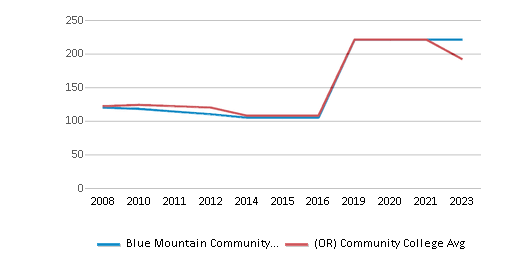
School Calendar
Student Body
The student population of Blue Mountain Community College has grown by 83% over five years.
The student:teacher ratio of 13:1 has increased from 7:1 over five years.
The Blue Mountain Community College diversity score of 0.72 is more than the state average of 0.66. The school's diversity has grown by 27% over five years.
Total Enrollment
2,859 students
729 students
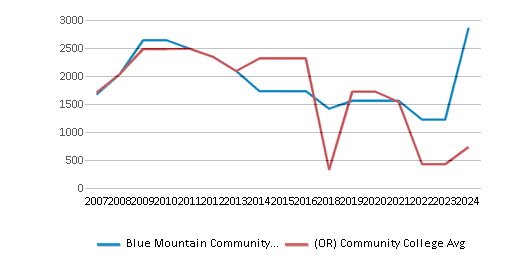
Student : Teacher Ratio
13:1
21:1
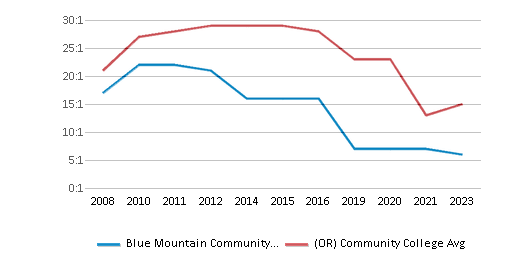
# Full-Time Students
706 students
310 students
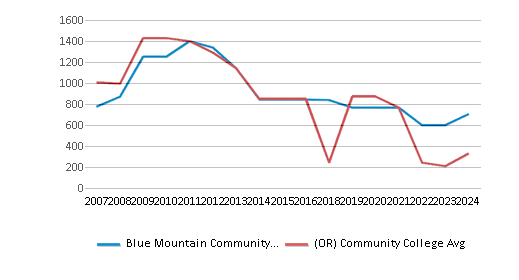
# Part-Time Students
2,153 students
2,153 students
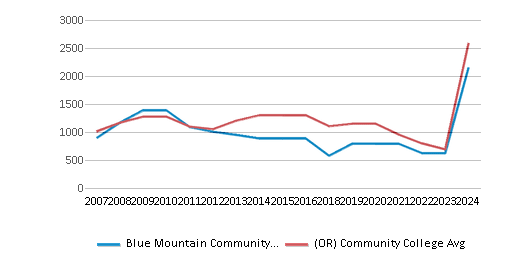
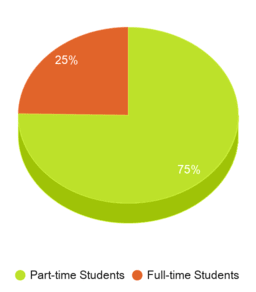
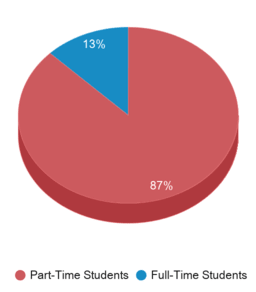
# Enrollment Undergraduate
285 students
339 students
# Full-Time Undergraduate Students
706 students
310 students

# Full-Time Graduate Students
n/a
193 students
# Part-Time Undergraduate Students
2,153 students
2,153 students
# Part-Time Graduate Students
n/a
153 students
Total Dormitory Capacity
n/a
270 students
% American Indian/Alaskan
3%
1%
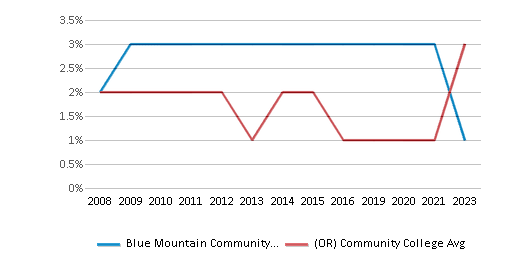
% Asian
1%
5%
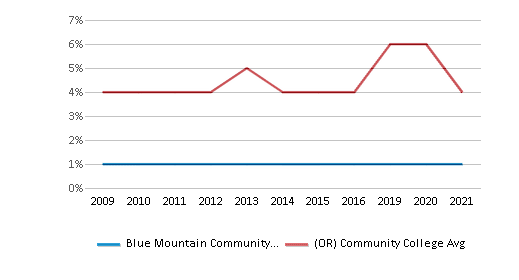
% Hispanic
30%
20%
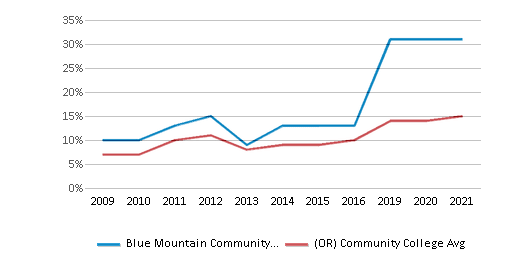
% Black
1%
3%

% White
43%
53%
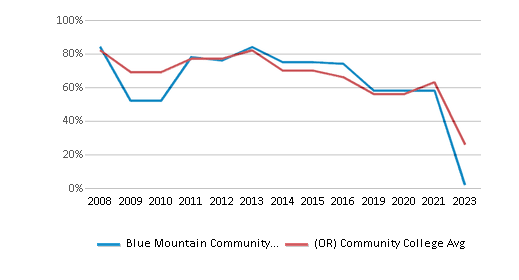
% Hawaiian
n/a
1%
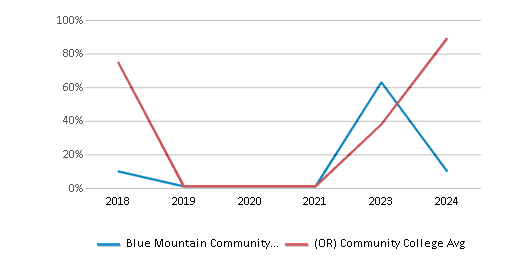
% Two or more races
2%
5%
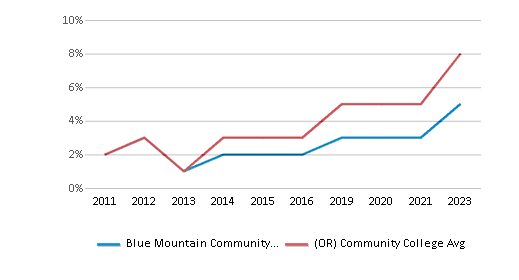
% Non Resident races
n/a
1%
% Unknown races
21%
11%
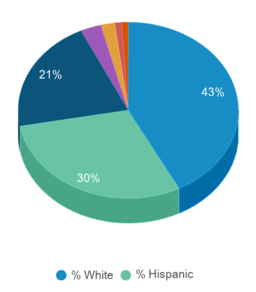
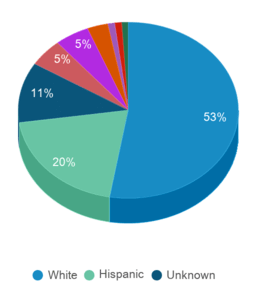
Diversity Score
0.72
0.66
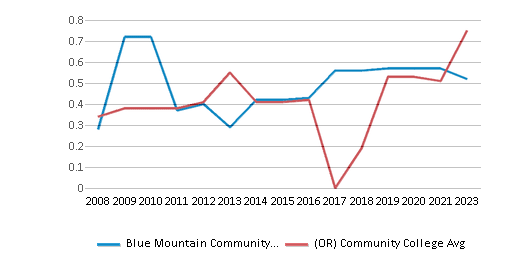
College Completion Rate (Students who graduate in less than 4 years)
0.2159%
0.4783%
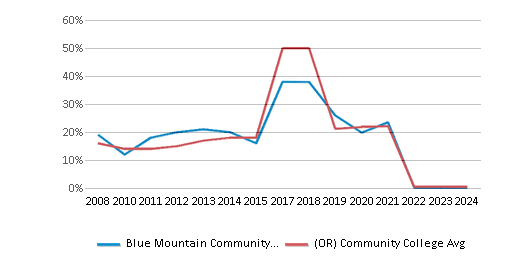
College Completion Rate (Students who graduate in 4 years or more than 4 years)
n/a
0.5833%
Average Graduate Earnings (10 Years)
$34,000
$33,800
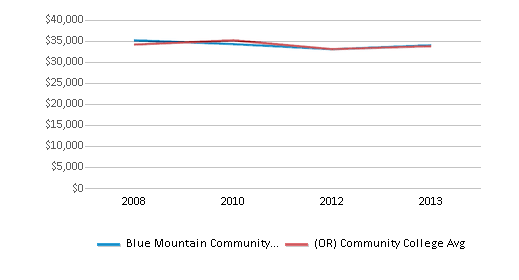
Tuition and Acceptance Rate
The public in-state tuition of $6,188 is more than the state average of $4,172. The in-state tuition has stayed relatively flat over four years.
The public out-state tuition of $8,618 is more than the state average of $6,738. The out-state tuition has stayed relatively flat over four years.
In-State Tuition Fees
$6,188
$4,172
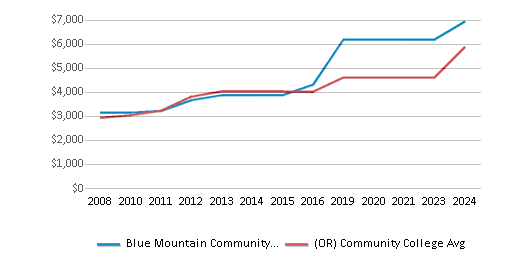
Out-State Tuition Fees
$8,618
$6,738

Tuition Notes
Tuition & Fees based on $108 per credit hour + $29.50 in fees per credit, based on 15 credits
% Students Receiving Some Financial Aid
95%
79%
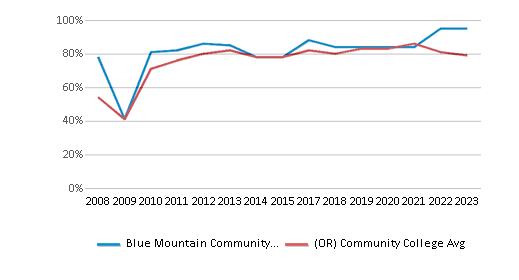
Median Debt for Graduates
$12,074
$12,875
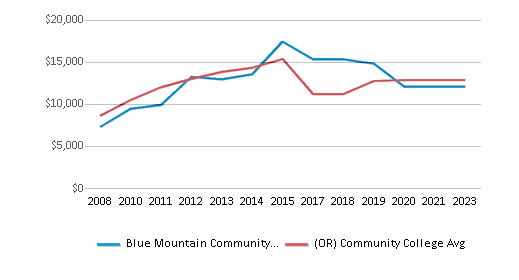
Median Debt for Dropouts
$6,230
$6,334
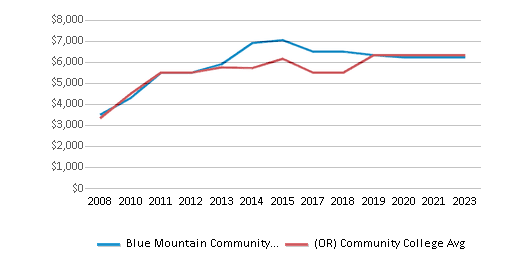
Acceptance Rate
n/a
100%
Sports
Total Sports Offered
6 sports
Sports
Baseball, Basketball, Equestrian, Soccer, Softball, Volleyball
Extracurriculars
Total ExtracurricularsTotal Extra-curric.
7 extracurriculars
ExtracurricularsExtra-curric.
Club or Organization:
FFA, Mountain Biking, Phi Beta Lambda, Phi Theta Kappa Honor Society, Spanish Club, Student Ambassadors, Student Government Association
FFA, Mountain Biking, Phi Beta Lambda, Phi Theta Kappa Honor Society, Spanish Club, Student Ambassadors, Student Government Association
Source: 2024 (or latest year available) Integrated Postsecondary Education Data System (IPEDS) , School Administrators
School Notes
- Blue Mountain Community College was founded in 1962 to meet the growing education, training, and cultural needs of northeastern Oregon. Since then, it has expanded and evolved into a comprehensive community college that serves a diverse community of life-long learners with facilities in Baker City, Boardman, Hermiston, Milton Freewater, and Pendleton. Blue Mountain Community College's main campus is located in northeastern Oregon surrounded by the natural beauty of rich wheat fields and the foothills of the Blue Mountains. Our scenic 175-acre hilltop site overlooks Pendleton, a city with a population of 16,180 and the county seat of Umatilla County. We are located 200 miles east of Portland and nearly the same distance from Seattle, Spokane and Boise. The College's buildings date from 1965 to our new science and technology facility which was first occupied in September 2000. In November of 1998, the voters of our service district passed a building and technology bond aimed at renewing and expanding existing facilities, and building new educational sites, which will help BMCC transition into the future. At Blue Mountain Community College (BMCC) you can earn the Associate of Arts Oregon Transfer(AAOT), The Associate of Science(AS), The Associate of Applied Science(AAS), The Associate Degree in General Studies(AGS), and Certificates. BMCC is a public, two-year coeducational college accredited by the Northwest Commission on College and Universities (NWCCU).
Frequently Asked Questions
How much does Blue Mountain Community College cost?
Blue Mountain Community College's tuition is approximately $6,188 for In-State students and $8,618 for Out-State students.
What sports does Blue Mountain Community College offer?
Blue Mountain Community College offers 6 interscholastic sports: Baseball, Basketball, Equestrian, Soccer, Softball and Volleyball.
What is Blue Mountain Community College's ranking?
Blue Mountain Community College ranks among the top 20% of community college in Oregon for: Diversity in US community colleges and Percent of students receiving financial aid.
Recent Articles

Obtaining Your Bachelor's Degree at a Community College
Explore the evolving landscape of community colleges offering bachelor's degrees, addressing affordability, accessibility, and workforce needs.

A to Z of Community College Certificates and Courses
From business and healthcare to technology and skilled trades, the article showcases the breadth of options available to students seeking to enhance their knowledge, develop new skills, or pursue career advancement.

What is a Community College?
This comprehensive guide explains what a community college is, its history, and its role in higher education. It covers the types of programs offered, differences from four-year colleges, benefits of attending, and important considerations for prospective students, providing valuable insights for those exploring educational options.
















